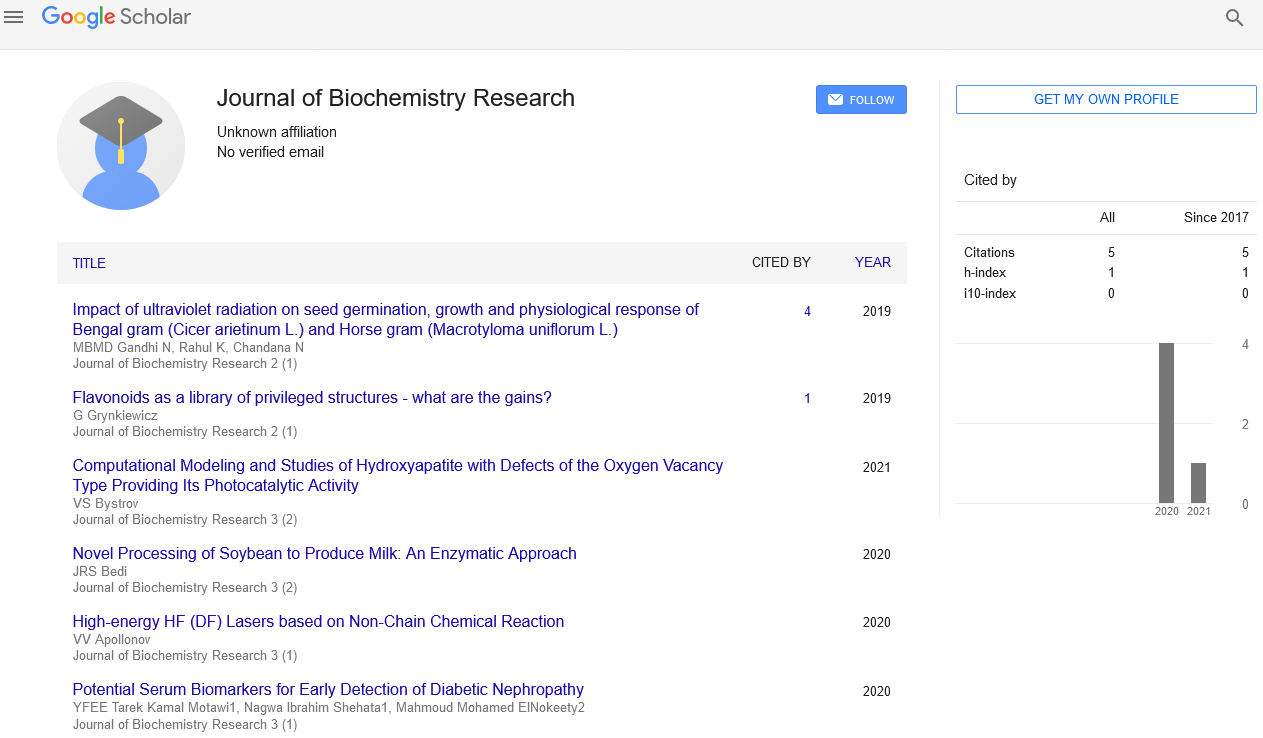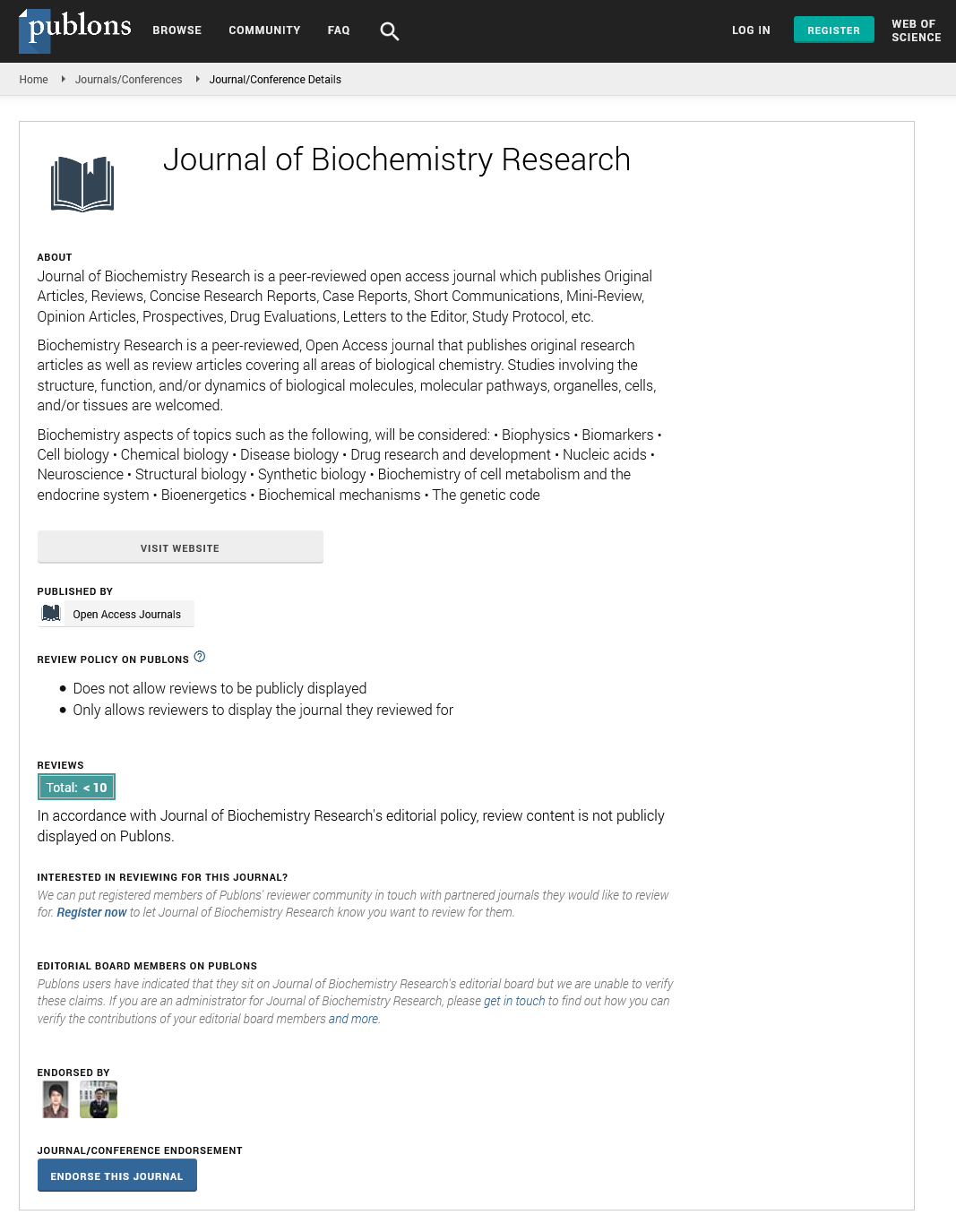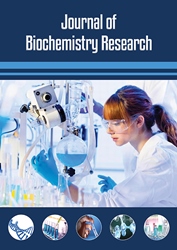Mini Review - Journal of Biochemistry Research (2023) Volume 6, Issue 1
Origin and evolution of the genetic code: Genetic Techniques and Biochemistry
Dr. Abhishek Narayan Bharati*
Department of genetic Engineering and Biochemistry, University of AKETU, India
Department of genetic Engineering and Biochemistry, University of AKETU, India
E-mail: abhishek.nb@gmail.com
Received: 02-Feb-2023, Manuscript No. oabr-23-89000; Editor assigned: 06-Feb-2023, PreQC No. oabr-23- 89000; Reviewed: 20- Feb-2023, QC No. oabr-23-89000; Revised: 22-Feb- 2023, Manuscript No. oabr-23-89000 (R); Published: 28-Feb-2023; DOI: 10.37532/oabr.2023.6(1).01-03
Abstract
The study of genes and factors connected to all aspects of genes is referred to as genetics, which is the study of heredity. Gregory Mendel's writings in the middle of the 19th century marked the beginning of the scientific history of genetics. Genetics was primarily theoretical prior to Mendel, but after Mendel, the field expanded to include experimental genetics. In the first half of the 20th century, all areas of genetics and genetic technology made progress that laid the groundwork for subsequent advancements. The molecular foundations of genetics have become easier to comprehend in the second half of the twentieth century. The Human Genome Project's completion and subsequent rapid technological advancements have significantly enhanced our understanding of genetic factors, their effects on human life, and diseases. Over 1800 disease genes have been identified, over 2000 genetic tests have become available, and at least 350 products based on biotechnology have been introduced to the market. The pace of biological research has sped up dramatically thanks to new technologies, particularly next-generation sequencing, which has also raised expectations. This paper provides a concise history of genetics and brief explanations of the most common genetic methods. The deterioration of an organism's structure and function is referred to as aging, and molecular and cellular modifications can have a variety of individual-level effects over a lifetime. Hereditary, environmental, and stochastic factors all play a role in the accumulation of molecular errors that compromise adult stem cell functions. These interactions are the result of genetic and epigenetic interactions. In this section, we go over the known genetic factors that affect aging.
Keywords
Longevity • Environment • Genes • Progerias • DNA repair and telomeres • Genetics • Science of genetics • Experimental genetics • Technological advancements
Introduction
Genetics analyses have emerged as essential components of clinical practice and research as a result of rapid advancements in genomic technologies. In the past ten years, significant progress has been made in deciphering the underlying mechanisms of genetic disorders [1]. In addition, landmarks in genetic history are summarized in after the completion of the Human Genome Project, which coincided with advancements in computer technology, genetic testing methods have become widely available and can be performed even in small laboratories. We are at the beginning of a new era in human health with the application of genetic testing for personalized medicine.
The accumulation of damage in molecules, cells, and tissues over a lifetime is what is known as aging, which has an impact on physiological functions. An organism’s ability to maintain homeostasis under stressful conditions is frequently compromised as a result, increasing the likelihood of numerous diseases like cancer, cardiovascular, and neurodegenerative conditions and early death [2]. The complexity of the process as well as the considerable variation between individuals and even between body tissues makes it difficult to identify the factors that regulate aging. Cell senescence, a result of exposure to intrinsic and extrinsic aging factors, is the most prominent cellular event in an aged tissue; It is characterized by the gradual accumulation of DNA damage and epigenetic modifications to the structure of DNA, both of which have an impact on the correct expression of genes and alter cell function [3].
Shortly after the genetic code of Escherichia coli was deciphered, it was recognized that this particular mapping of 64 codons to 20 amino acids and two punctuation marks (start and stop signals) is shared, with relatively minor modifications, by all known life forms on earth. Even a perfunctory inspection of the standard genetic code that the arrangement of amino acid assignments is manifestly nonrandom. Generally, related codons tend to code for either the same or two related amino acids amino acids that are physic-chemically similar [4].
Techniques of Genetic and code is evolvable
The code expansion theory proposed in Crick’s seminal paper posits that the actual allocation of amino acids to codons is mainly accidental and ‘yet related amino acids would be expected to have related codons’. This concept is known as ‘frozen accident theory’ because Crick maintained, following the earlier argument of Hine Gardner and Engel erg that, after the primordial genetic code expanded to incorporate all 20 modern amino acids, any change in the code would result in multiple, simultaneous changes in protein sequences and, consequently, would be lethal, hence the universality of the code [5]. Today, there is ample evidence that the standard code is not literally universal but is prone to significant modifications, albeit without change to its basic organization.
The fruit fly genes were mapped in 1911 to create the first genetic map. It was not understood until the middle of the 1900s that the structure of hereditary genetic material was what passed on traits from one generation to the next. The double-stranded, helical, complementary, and antiparallel DNA model was first proposed by Watson and Crick in 1953 [6]. In 1962, they shared the Nobel Prize in Medicine for this significant discovery regarding the structure of DNA. By defining that a codon, which is a sequence of three adjacent nucleotides, codes for the amino acids, and the genetic code in DNA was finally discovered in 1966. The 50 years since the discovery of DNA and chromosomes paved the way for rapid advancements in genetics and the development of new technologies.
Genetic code and collective evolution
Whether the code reflects biosynthetic pathways according to the coevolution theory or was shaped by adaptive evolutionary forces to minimize the burden caused by improper translated proteins or even to maximize the rate of the adaptive evolution of proteins, a fundamental but often overlooked question is why the code is universal [7]. Of course, the stereo chemical theory, in principle, could offer a simple solution, namely, that the codon assignments in the standard code are unequivocally dictated by the specific affinity between amino acids and their cognate codons. As noticed above, however, the affinities are equivocal and weak, and do not account for the error-minimization property of the code. An alternative could be that the code evolved to perfection in terms of robustness to translational errors or, perhaps, some other optimization criteria, and this (nearly) perfect standard code outcompeted all other versions. We have seen, however, that, at least with respect to error minimization, this is far from being the case [8]. What remains as an explanation of the code’s universality is some version of frozen accident combined with selection that brought the code to a relatively high robustness that was sufficient for the evolution of complex life.
Genetic Factors and DNA Damage
An exponential rise in the incidence and mortality rates of cancer and non-cancerous diseases, as well as progressive tissue degeneration and atrophy brought on by a decline in the function of adult or somatic stem cells, is a major contributor to aging [9]. Throughout their lives, cells are constantly exposed to an unhealthy environment. The dysfunction that comes with aging is made worse by more damage to cells. The progeroid syndromes, whose symptoms begin early in life and are caused by a deficiency in the mechanisms involved in DNA repair, are the best example of DNA damage as a cause of aging. Certain gene mutations increase longevity by enhancing stress resistance and reducing damage accumulation. For instance, in vitro-cultured cells’ resistance to apoptosis following oxidative stress is enhanced by a mutation in the gene that encodes the oxidative stress response protein p66shc. Mice with this mutation live longer and are protected from a variety of diseases associated with aging [10].
Conclusion
Aging is a complex process that can be described as a group of cellular functions that participate in an integrated way in the process of senescence. The great variability in longevity between individuals of the same species suggests that the aging process is profoundly affected by processes that lead to the accumulation of errors that damage repair systems and compromise stem cell function. These changes can be caused through genetic and epigenetic mechanisms, which are influenced by genes, environmental and stochastic factors; the contribution of each of these factors remains to be determined by future studies. Further studies are needed to describe the pathways involved in age-related physiological alteration and predisposition to age-related pathological changes. Exploration of these functional connections might provide options to help develop more efficient anti-aging strategies to ameliorate senescence-related diseases. Exploration of these functional connections might provide options to help develop more efficient anti-aging strategies to ameliorate senescence-related diseases. If the developments in genetics and computer technologies continue to progress at their current speed, history has shown us we can look forward to some amazing developments in human life in the very near future. Some realistic scenarios of human life in the future could even see us carrying identity cards, which include our genome characteristics, rather than the format we are currently using. Gene corrections, cloned individuals and organs, and even genetic-based techniques as a primary laboratory analysis in almost all human diseases for a clinician will no longer be a dream. We have come to the point nowadays where genetic testing is commercially available; the individual now has the possible means to access this delicate information named as direct to consumer (DTC) genetic testing.
To conclude, in parallel with the rapid developments in the field of genetic technologies, ethical and legal issues regarding the implementation of those technologies need to be addressed. Because use of personal genetic information looks certain to directly impact our daily lives in the near future, protocols need to be discussed in detail, with guidelines provided and updated regularly as part of a regulated multidisciplinary approach.
Acknowledgement
None
Conflict of Interest
None
References
- Jacobs B, Bigdeli M, Annear PL et al. Addressing access barriers to health services: an analytical framework for selecting appropriate interventions in low-income Asian countries. Health Policy Plan. 27: 288-300 (2012).
- Carrillo JE, Carrillo VA, Perez HR et al. Defining and targeting health care access barriers. J Health Care Poor Underserved. 22: 562-75 (2011).
- Lewis RJ, Dutertre S, Vetter I et al. Conus venom peptide pharmacology. Pharmacological Reviews. 64: 259-98 (2012).
- Kobayashi H, Airway biofilms: implications for pathogenesis and therapy of respiratory tract infections. Respiratory medicine. 4: 241-253 (2005).
- Huang ES, Brown SE, Ewigman BG et al. (2007) Patient perceptions of quality of life with diabetes-related complications and treatments. Diabetes Care. 30: 2478-2483.
- Buehler AM, Cavalcanti AB, Berwanger O et al. (2013) Effect of tight blood glucose control versus conventional control in patients with type 2 diabetes mellitus: a systematic review with meta-analysis of randomized controlled trials. Cardiovascular Therapeutics. 31: 147-160.
- Pratley RE, Rosenstock J, Pi-Sunyer FX et al. Management of type 2 diabetes in treatment-naive elderly patients: benefits and risks of vildagliptin monotherapy. Diabetes Care. 30, 3017-3022 (2007).
- Meng Y, Bai H, Wang S et al. Efficacy of low carbohydrate diet for type 2 diabetes mellitus management: A systematic review and meta-analysis of randomized controlled trials. J Diabetes Res. 131: 124-131 (2017).
- Roberts CK, Won D, Pruthi S et al. Effect of a short-term diet and exercise intervention on oxidative stress, inflammation, MMP-9, and monocyte chemotactic activity in men with metabolic syndrome factors. J Appl Physiol. 100: 1657-65 (2006).
- Brand-Miller J, Foster-Powell K, Nutr M et al. Diets with a low glycemic index: from theory to practice. Nutrition Today. 34: 64-72 (1999).
Indexed at, Google Scholar, Crossref
Indexed at, Google Scholar, Crossref
Indexed at, Google Scholar, Crossref
Indexed at, Google Scholar, Crossref
Indexed at, Google Scholar, Crossref
Indexed at, Google Scholar, Crossref
Indexed at, Google Scholar, Crossref
Indexed at, Google Scholar, Crossref
Indexed at, Google Scholar, Crossref


